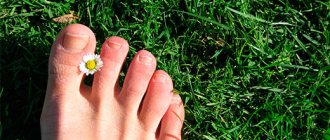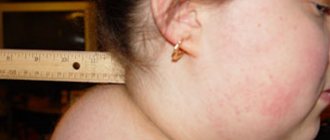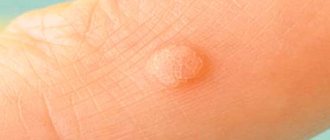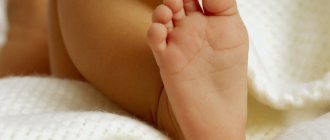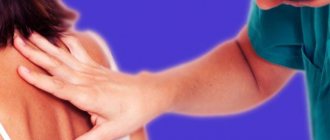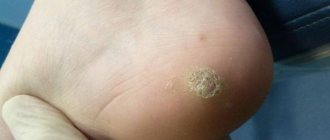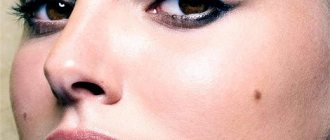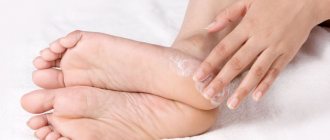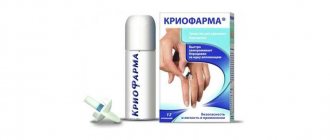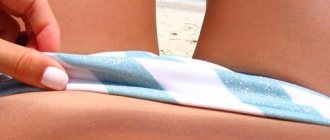They are often confused with dry calluses due to their external similarity and localization features. Incorrect treatment or ignoring the problem leads to relapses, severe pain, and proliferation of tumors. Getting rid of plantar warts is recommended in clinical settings. Doing this at home is much more difficult.
The mechanism of appearance of plantar warts
The type of wart associated with the circulation of the human papillomavirus in the blood is a flat, hard, oval or round lump on the foot with a clear outline. Its dimensions are quite large - 1-2 cm with a protrusion of 3 mm above the skin level. The color of the skin is preserved; it can be pinkish or coffee-colored.
At the initial stages, the surface of the spot is smooth; as it develops, a keratinized epidermis forms, changing color to gray-yellow.
Changes in education may occur over time:
- recess in the center;
- black or brown dots on the surface due to thrombosis of capillaries;
- peeling.
More often than not, such a wart is a single one. The appearance of new formations characterizes a highly active virus. Multiple growths give a mosaic pattern to the abnormal fragment of the sole.
In some cases, the formation eliminates itself, leaving no marks on the foot. More often, due to regular injury, the wart does not disappear without treatment; discomfort and pain when pressing and rubbing the wart on the insole of the shoe are added.
Characteristics of growths on the foot
Dermatologists say that pimples are simply a type of wart. It is classified as a separate nosology and has certain histological structural features, but the clinical picture and treatment methods are common.
Wart
Several types of benign neoplasms are combined into one nosology and are called warts. All of them are caused by the human papillomavirus and have the shape of a nodule or papilla.
Although HPV is constantly present in the human body, predisposing factors to the formation of growths include stress, decreased immune activity, and increased sweating. The difference between a wart and a thorn is not great.
Shipitsa
It is represented by a hard, clearly defined nodule localized on the plantar part of the foot. More often it is single in nature, but as the condition progresses, “daughter” growths are observed, which merge into mosaic plaques.
Home methods for foot removal
It is important to differentiate this element from calluses or hyperkeratoses. The plantar wart is separated from plantar palmar keratoderma in Reiter's syndrome. Syphilides have some similarity with a spine; more often they are not single in nature and are located in the form of rings or arcs.
Any types of removal should be carried out after dermatoscopy, PCR studies, and ultrasound of the area with pathology.
Removal of a foot growth is complicated by its deep, unlike papillomas, condylomas, root in the dermis.
Pharmacy drugs
Need advice from an experienced doctor?
Get a doctor's consultation online. Ask your question right now.
Ask a free question
Plantar warts can be removed from the roots using a comprehensive approach using antiviral agents and immunomodulatory drugs. Isoprinosine or its analogues are optimal for HPV therapy. They suppress the activity of the virus. The doctor selects the drug regimen based on the specific type of virus and the age characteristics of the patient. The medicine is used in adults; children can be treated from 3 years of age.
Interferon-containing drugs stimulate the immune system.
Local medications:
- lapis pencil;
- salicylic patch;
- ointments with antiviral activity;
- cauterizing liquids.
Lapis in stick form and patches are easy to use at home. They allow the drug to target the formation, accumulating for a long time in the pathological area.
Viferon ointment has both antiviral and immunomodulatory effects. It is effective, does not leave scars on the foot, and activates local immunity.
The drug can be used during pregnancy and lactation, in children over one year old. Riodoxol is characterized by antibacterial, antimycotic and antiviral activity. Oxolinic ointment is similar in effect.
Among the cauterizing home remedies, verrucacid is often recommended. They are used to treat warts.
Step-by-step algorithm:
- Steam your foot in hot water for 10 minutes.
- Dry with a towel.
- Apply the drug precisely.
- Do not apply a bandage or plaster.
Ferezol is similar in action to verrucacid. They remove the growth (on the toe, heel), causing a chemical burn. The skin first turns pale, then becomes hyperemic, and a wound defect appears with pain. After 2 weeks, healing is recorded.
Treatment of warts on the foot at home can be done using liquid nitrogen. The so-called cryodestruction, the effect of extremely low temperatures on the formation, gives the effect of deep freezing of the pathological tissue and its destruction.
Drug treatment
This method is considered the most common in medical practice. Treatment is carried out using medications in the form of alkalis and acids, followed by the use of healing and restorative ointments. Among them the following components and solutions can be noted:
- Tretinion, Solcoderm, Kolomak are salicylic acids with an admixture of nitrogen.
- Lapis pencil is a preparation containing silver nitrate. When combined with water, it oxidizes and negatively affects the tissues of the formations.
- Salipod is a patch that is often used to remove warts on a child’s heel.
- Verrucacid is a high concentration solution that helps eliminate the virus. Used to lubricate tumors.
- Kreofarma and Wartner Cryo are medications with a freezing effect. They cause cell death, accompanied by pain, after which the wart can be removed.
- Potassium permanganate and iodine for treating the affected foot.
After treatment with these drugs, it is necessary that the wounds left after warts heal faster. To do this, use various healing creams or ointments.
How to prevent relapse
The success of wart treatment lies in its early and deep removal. It must be remembered that getting rid of the growth does not protect against relapse; the infection, without immunocorrection, continues to circulate in the blood and infect surrounding tissues. In conditions of suppressed immunity, re-emergence of the virus is almost inevitable. The main attention should be paid to the primary prevention of warts on the leg, which consists of preventing HPV infection.
Precautionary measures:
- wearing personal shoes in water parks, baths, saunas, swimming pools and showers;
- medical pedicure;
- peeling, foot scrubbing;
- treatment of thickened areas with keratolytics.
Patients with deformed limbs need to use orthopedic insoles, interdigital spacers, and unloading correctors. If your feet sweat, it is important to choose shoes made of genuine leather and choose drying creams. For cracking dry skin, moisturizers with urea and baths with the addition of herbal extracts are suitable. Prevention of the secondary appearance of a plantar wart consists of courses of antiviral drugs and immunomodulators according to the scheme after removal of the growth.
Symptoms
After infection, it can take from several weeks to six months. With the initial signs of the disease, the surface of the growths is smooth, but as they grow, they take on a rough appearance. The wart causes pain and discomfort when walking.
The neoplasm is uneven in shape, often flesh-colored. You can often see dark spots inside the growth from clogged blood vessels. Localization is usually spotty; you can rarely notice several growths nearby.
The need to seek qualified help
It is highly undesirable to get rid of warts on the feet at home on your own, without consulting a dermatologist. If formations occur regularly or multiply, you should immediately contact a specialist. Do not forget about oncological alertness, which should be exercised in case of various skin defects. If the picture is ambiguous with malignant signs, it is necessary to contact a dermatologist-oncologist, undergo dermatoscopy, and ultrasound.
The doctor prescribes a PCR test, which will show the presence of specific strains of the papilloma virus in the blood and their activity. Based on this analysis, a course of immunity-boosting drugs is selected and antiviral agents are prescribed.
There are formations that cannot be cured with ointments, liquids, or patches. Only a doctor will provide qualified assistance. Small warts on the skin of the foot can be removed using electrocoagulation. Deeper ones are burned out without pain and subsequent tissue scarring with the laser. The radioknife removes the growth, cauterizes nearby vessels, preventing the virus from entering the blood. Extensive skin defects are excised with a scalpel under local anesthesia with possible scarring.
Differences and similarities
It is very important for further treatment to distinguish a plantar wart from an area of hyperkeratosis and callus. To do this, dermatoscopy and preliminary scraping of the upper layer of the tumor are performed.
Difference between a wart and a callus
| Signs | Shipitsa | Corn |
| After taking a hot bath | The surface is rough. | The surface is smooth. |
| Height | Constant, intense. | Very slow. |
| Soreness | Weakly expressed. | Very pronounced. |
| Surface | Lumpy, reminiscent of cauliflower. | Smooth. |
| Dermis drawing | The lines “bypass” the growth. | The skin pattern is preserved. |
It is important to be able to distinguish a wart from a callus; if a human papillomavirus is detected, special treatment is required.
Sometimes these signs are not enough to make an accurate diagnosis and PCR diagnostics are required to confirm HPV. With its help, the type of virus is determined and drug therapy is selected. To verify the depth of invasion (germination), the dermatologist prescribes an additional ultrasound of the formation. After surgical removal, the excised tissue is checked by pathologists to exclude cancer. In 15% of cases, formations go away on their own, while in the remaining 85%, medical intervention is required.
Contraindications for home removal
Patients with a history of allergic manifestations, chronic pathologies, women who are pregnant, or breastfeeding should not be treated at home or select medications on their own. Self-medication of children in the first year of life without consultation of a pediatrician or pediatric dermatologist is excluded. The medicine is selected and prescribed by a doctor, who also evaluates contraindications and the effectiveness of treatment.
Do not pick at the formation, cut it with pumice or abrasive files at home. Working with an instrument that is not sterile can lead to sepsis, and attempts to roughly remove a growth on the foot often lead to skin injuries and the spread of infection to healthy areas, which leads to further escalation of the disease.
If you have consulted a doctor and prescribed treatment, including surgery, you should not carry it out for colds, fever, flu, exacerbation of cardiovascular diseases and pathologies of other organs, systems, herpes, inflammation of the skin around the wart.
The article has been reviewed by the site editors
People at high risk of infection
People in professions such as construction workers, workers in the meat processing and fishing industries are at high risk of infection.
The virus can be acquired by visiting swimming pools and other public places. People with weak immune systems, patients with cancer and AIDS have a high risk of infection.
Prevention
The most effective way to protect yourself from this disease is to strengthen your immune system.
It is necessary to eat healthy foods, often walk outdoors, exercise and breathe fresh air. If necessary, take medications that strengthen the immune system.
When visiting the pool, use only your own shoes and towel. You should only wear comfortable and warm shoes appropriate for the season. And also avoid long-term stress and worries in life.
